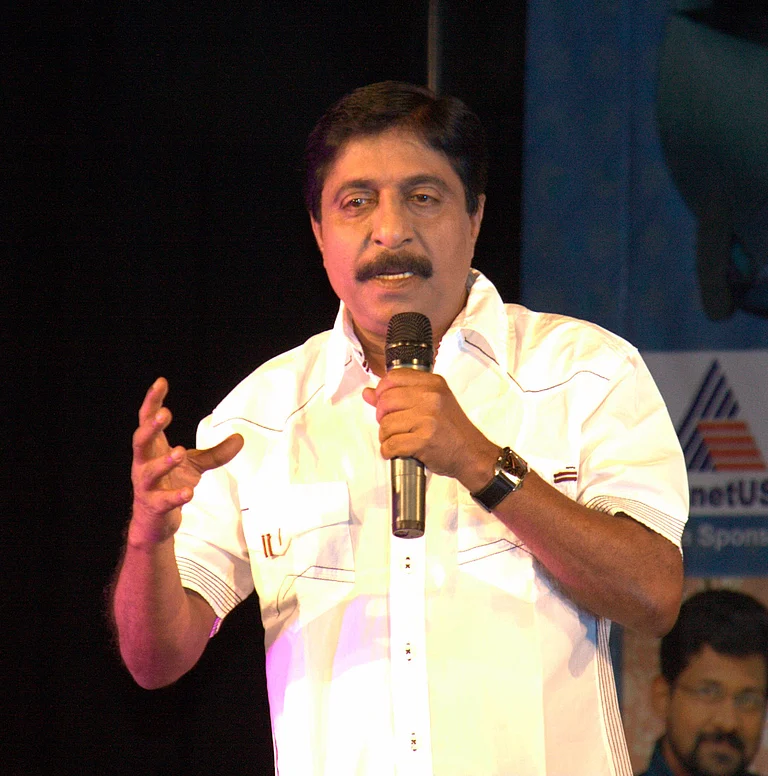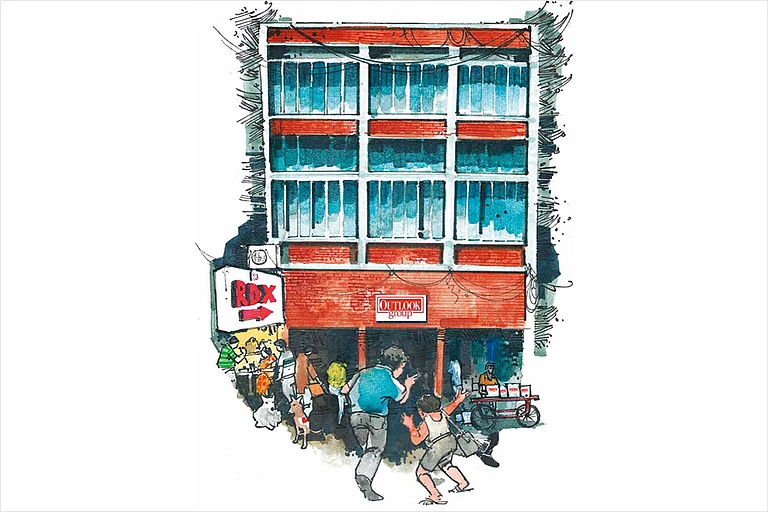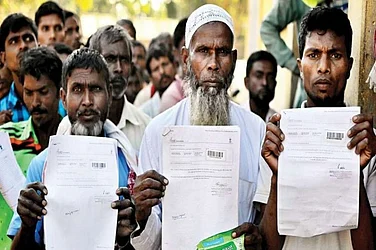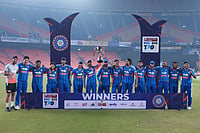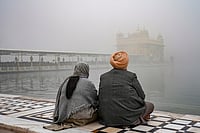Memories co-exist differently and become different stories in their retelling; time marches on, in the meanwhile, leaving a trail of images behind, when the custodian of the stories has long gone.
Mashi in our mother’s accounts is a very different person from the one we loved in our growing up years. They were nine siblings and the family lived in a house with a rambling garden. Ma, Konchi and her younger brother Falgoo were inseparable and got into frequent trouble because of my mother’s mischievous pranks. Mahasweta was the eldest and mostly away studying at Viswa Bharati, Santiniketan, but when she came home, their wild ways came to an abrupt end, so they tried to find novel ways to avoid her. Mashi’s account of these days were somewhat different, like the time she couldn’t find the younger siblings anywhere, till a hushed whisper and muffled giggle led her to a tar drum outside, where the two had sought a secure hiding place. She had dragged them out, black from head to toe, dripping with tar and scrubbed them so hard that they went without eyebrows for weeks afterwards.
As children we eagerly looked forward to our vacations in Baharampur where my grandparents, Dharitri Debi and Manish Ghatak, lived. The house, with its maze of rooms, passages and niches, had books everywhere and many an hour was spent reading from my grandfather’s vast collection, where we first had our encounter with Doctor Doolittle and Miss Marple. Freed from school, we ran amuck, till we heard Mashi’s unmistakable voice ordering us homewards. We dared not disobey; she was an authority we respected, but mostly worshipped.
Her son Nabarun was the first in our generation but we didn’t see much of him, since he lived with his father, Bijon Bhattacharya. Amongst the cousins present, I was therefore eldest, followed by a brood of boy and girl cousins.
When evening descended and the neighbourhood grew silent, interrupted with the occasional hooting of an owl, Mashi told us stories. Her voice brought alive a Malay coolie who lost his arm and haunted the rooms of a doctor, whispering, ‘Doctor, what have you done to my arm?’ Or the sahib who summoned nightly his long-departed pet dog, its spirit appearing without fail at his master’s whistle. Or that secret cemetery in Bombay, where a young Anglo-Indian woman stood every night, hailing a taxi to take her home. Mahasweta was so brilliant at storytelling that the world seemed to recede, only her voice remained—now a Malay youth; then again, a sahib with heavily accented Bengali or a lost young woman. Without realising it we had huddled closer to each other, our mothers and grandparents too drawn to our circle, loth to leave the room. Occasionally, she told us funny anecdotes, a little tweaked, of family members and their cow Nyadosh, who chewed paper instead of grass and went for the occasional stroll to the terrace, clippity clop over the staircase, to stand there and gaze up at the moon.
Mashi also told us hilarious incidents about her father’s eccentricities. Like the occasion when he tried to impress his disbelieving wife that he had been successful in creating a Persian rose garden almost overnight, when actually he had got the hapless gardeners to place the flowers in their pots into the soil. Gradually, we grew up and visits became infrequent to the house called Dharitri, in Laldighi.

Everyday things used by Mahasweta Devi in a museum at her Calcutta home
In our own lives there was the turmoil of our parents’ separation. My brother and I had to spend months in relatives’ homes. We were a little awkward when it came to staying with Mashi, who was then married to Asit Gupta and lived in Calcutta. But within days, we had been made to feel at home. In the evenings, Mashi sat us down told us stories, that of Jim Corbett and the man-eater of Rudraprayag or other tales of valour that held us spellbound. Yet later, as adolescents, the stories had become real-life incidents, and we learnt about the Naxal movement from Mashi when she visited us, often very upset at things she had witnessed first-hand that very day. Long before Shyamanad Jalan had directed and staged Haazar Chaurasi ki Ma we had heard of the real-life mother whose name might or might not have been Sujata. By this time, we were reading Mashi’s books. Mashi had started editing the quarterly Bortika after my grandfather’s death and through its pages we read of marginalised peoples, grassroots issues and of landless labourers and their struggles, especially in eastern India. Mashi’s political activism had given her a new standing in a world where few had ventured before; she now became their ‘Ma’, a fiercely outspoken leader who would write fearlessly about caste, class, and patriarchy, taking her subjects from subaltern lives. Aranyer Adhikar (The Rights of the Forest) is a brilliantly researched historical novel about the Munda Insurrection of 1899-1900, where she explores a narrative that is literary Bengali, bureaucratic Bengali and tribal Bengali. Her iconic stature of a Devi happened as she experimented with historical fiction, researching every angle she wrote about. As Gayatri Spivak writes: “The plausibility of a Jashoda (Stanadayini or Breast-Giver), a Draupadi (Draupadi), a Birsa Munda (Aranyer Adhikar) is that they could have existed as subalterns in a specific historical moment imagined and tested by orthodox assumptions.” By Devi’s own account, Stanadayini is a parable of India after decolonisation.
One afternoon, after a long conversation, I had asked Mashi if she would allow me to work on Breast Stories as a curatorial project, with artists and filmmakers. She had agreed and wrote me a letter of consent with her permission.
An excerpt comes to mind from the book: “For twelve years men run the hunt. Then comes the women’s turn. It’s Jani Parab. Like the men they too go out with bow and arrow. They run in forests and hills. They kill hedgehogs, rabbits, birds. Then they picnic together, drink liquor, sing and return home. They do exactly what men do. Once in twelve years they light the fire of the spring festival and start talking. Budhni tells stories. That time we killed a leopard. I was young then. The old women listen, the ageing women cook, the young women sing. Jani Parab is a very exciting festival. That day every woman, in every household, goes out.... The whole day the women are at liberty. This is obviously a survival of an ancient custom. As soon as the contractor leapt for her body, to Mary Oraon’s thinking, he became an animal, a hunt animal. The hunt is a tremendous release, purification. On that day, the hunt is not a sin. The killing gives her tremendous release.”
Later, I had met with Amar Kanwar for my project on Breast Stories, aware that his work, The Lightning Testimonies, as an audio-visual narrative, had addressed exploitation and violence almost philosophically. Kanwar had refrained from showing a single explicit scene of sexual violence. Yet the haunting music and lingering footage of benign landscapes and beautiful flowers never let you wander too far from the scenes of the crime, which made it more brutal, visceral and visual by its sheer absence. Lightning Testimonies had included a section on Draupadi, but the idea had been to collaborate with artists on the other stories from Breast Stories. Maybe the time has come to restart the project; maybe it was our turn to tell Mahasweta Devi’s stories through diverse mediums, to a wider audience.
(This appeared in the print edition as "Tales Like Burning Embers")
ALSO READ
Ina Puri is a writer, biographer and art curator









